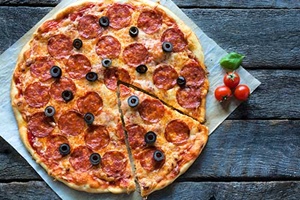Eating different brands of the same food product could contribute to overconsumption
11 May 2015
People who eat different types and brands of commonly available food items, such as pizza, are more likely to overeat than people who tend to consume the same brand, according to new research conducted at the University of Bristol.
 | |
| The researchers examined the eating behaviour of people who ate several different makes and varieties of pepperoni pizza |
As part of her work as a post-doctoral researcher in Bristol's School of Experimental Psychology, Dr Charlotte Hardman, now at the University of Liverpool's Institute of Psychology, Health and Society, examined the eating behaviour of nearly 200 people who ate several different makes and varieties of pepperoni pizza, and those who tended to consume the same brand and type of pizza.
The research was part of a three year, BBSRC-funded project, led by Professor Jeff Brunstrom at the University of Bristol and the first study of its kind to look at the effect of the wide variety of types and brands of mass-produced foods on consumption. The number of varieties of the same food product that are available to consumers has increased dramatically since the 1970s and the use of low-energy sweeteners and fat substitutes means that the calorie content can vary considerably.
Researchers in Bristol's Nutrition and Behaviour Unit identified over 70 different types of pepperoni pizzas which are available in supermarkets and from well-known takeaway suppliers. Within these different brands and types, the calorie content differed by more than 300 per cent (the lowest was 501 calories per pizza, and the highest contained 1909 calories per pizza).
They found that participants who regularly ate different varieties of pepperoni pizza failed to compensate for the calories in pizza at a later eating occasion and went on to eat more additional food than the participants who usually ate the same variety of pizza. These participants also believed that a slice of pepperoni pizza would be less filling.
Dr Hardman says, ''There has been a lot of research into the effects of portion sizes and the availability of energy-dense food on overeating and obesity. However, this is the first time that the number of different varieties within a single food that people eat has been examined. We used pepperoni pizza in this study, but it could apply to other mass produced food items which are available to buy in many varieties and by many manufacturers.
''We found that people who ate a wide range of different brands and types of pepperoni pizza were more likely to carry on eating more, and were more likely to think the pizza was less filling.
''It would appear that this high variability of food items makes it more difficult for people to learn about food and manage their consumption which exposes a new feature of Western diets and which has potential public health implications. ''
The research has been published in PLoS ONE (Public Library of Sciences).






















